The Victor-Victrola Page
 Section One:
Identifying Victor Products
Section One:
Identifying Victor Products
Do I really have a
Victor Talking Machine product?? Victor, Victrola,
Electrola and Orthophonic, are the brand names for phonographs made
by the Victor Talking Machine of Camden, New Jersey. Victor was an independent
company from 1901-1929, and was
not affiliated with RCA. The RCA Corporation bought Victor in late 1929,
and they continued to use the Victor and Victrola names and logos on their products for
many years after the purchase (e.g. "RCA Victor"). Thus, you can find "RCA
Victor" or "Victrola" products that were made by RCA
(or later by other companies) all the way up to today. Our expertise is
only with 1901-1929 Victor Talking Machine Company products.
RCA products are not covered on this
website. Please don't email us asking about your 1936 (or 1958)
Radio-Phono
Combination "RCA Victrola", because unfortunately, we have no data on RCA-Victor
products.
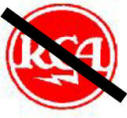
All
Victor products are clearly marked in several places with the words "Victor
Talking Machine Company" (not RCA) identification and the dog/phonograph logo.
See example on left. If you can't find
these identifiers somewhere on your phonograph, or if it says "RCA"
somewhere, it is not a Victor Talking Machine product! There is
usually a metal dataplate near the turntable (or under it) which has model
and serial number information. We will cover the topic of deciphering the
dataplate information as you continue to read onward.
If your phonograph says "Edison", "Sonora", "Columbia" "RCA" or anything except Victor Talking Machine Co. on the label or decal, it is NOT a Victor Phonograph. There were literally hundreds of different phonograph brands during the early part of this century, and some people incorrectly call them all Victrolas. Just like they incorrectly call all copy machines "Xerox Machines". The other brands are not Victrolas, they are Edison or Sonora or Columbia (or whatever) phonographs. If you can't find the logo...you don't have a Victor!
If you want information on other brands, we suggest that you search the links on the Websites of The Antique Phonograph Society or the Canadian Antique Phonograph Society. These organizations have many outstanding collectors who specialize in different brands of phonographs. Sorry to beat this point to death, but about 30% of all emails we receive are people asking for information on non-Victor products.
THESE ARE NOT VICTOR TALKING MACHINE COMPANY PHONOGRAPHS!!
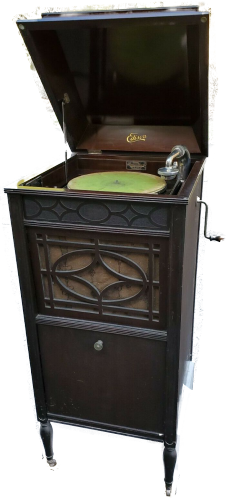
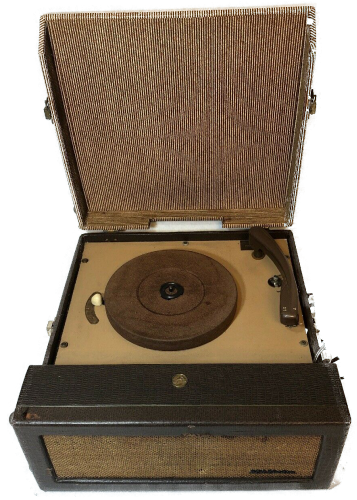
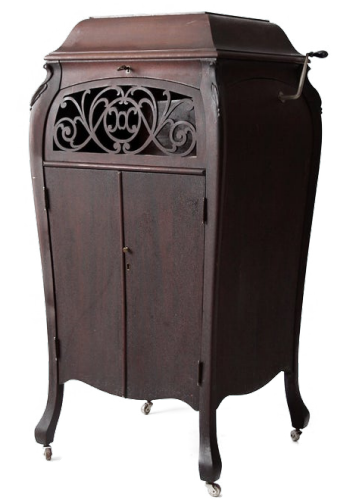
The machine on the left is an Edison Wind-Up Phonograph. In the center is a 1940's RCA Victor "Victrola" Radio/Phono set. On the right, a Sonora phonograph. The Edison and Sonora were not made by Victor and thus are not covered on this website. RCA bought Victor in 1929, and continued the Victrola name for many years. RCA products are also not covered here.
"HIS MASTERS VOICE" (HMV) Products:
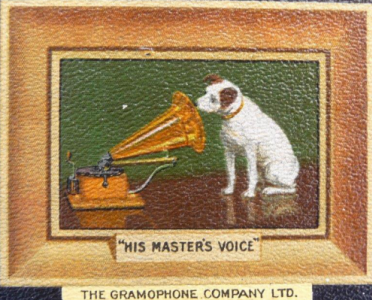
Does your phonograph have the dog and phonograph logo or decal with "The Gramophone Company Limited" (rather than "Victor Talking Machine") denoted on it?
Now this gets confusing. "His Masters Voice" was Victor's trademark advertising phrase in the USA, but it was not used as a brand name. So if you have "His Masters Voice" written as the brand name on a decal or metal plate (instead of "Victor" or "Victor Talking Machine Company"), along with "The Gramophone Company LTD", you have an "HMV" product, made in Great Britain by The Gramophone Company, which licensed the trademark dog and phonograph logo for use in Europe. This company was only indirectly associated with the Victor Talking Machine Company of Camden USA, although they did share some similar designs and products. HMV phonographs are not covered on this website, and regretfully, we have no information on these machines. NOTE: There are also many fake phonographs which use this HMV designation, please see the article at the bottom of this page.
THESE ARE VICTOR TALKING MACHINE PHONOGRAPHS!!
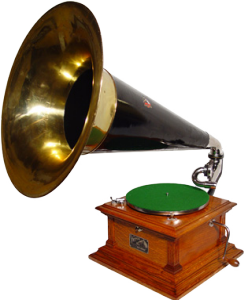 EXTERNAL HORN
VICTOR.
If
your Victor-labeled phonograph has an outside horn like the one to the left, it
is called an External Horn Victor (or just "Victor"). These
machines are desirable collector items, and usually date from between
1901 up to the early 1920's. Note that, in many cases, you may come across an old
external horn phonograph with a missing horn that looks like a simple tabletop
phonograph. These are easy to identify, as they have no doors or openings on the
front of the cabinet for the sound to exit. Note that
this is not a "Victrola" (which has the horn concealed inside), but is correctly
termed a "Victor".
EXTERNAL HORN
VICTOR.
If
your Victor-labeled phonograph has an outside horn like the one to the left, it
is called an External Horn Victor (or just "Victor"). These
machines are desirable collector items, and usually date from between
1901 up to the early 1920's. Note that, in many cases, you may come across an old
external horn phonograph with a missing horn that looks like a simple tabletop
phonograph. These are easy to identify, as they have no doors or openings on the
front of the cabinet for the sound to exit. Note that
this is not a "Victrola" (which has the horn concealed inside), but is correctly
termed a "Victor".
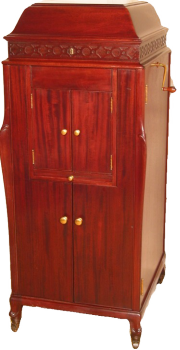 INTERNAL HORN
VICTROLA.
If your Victor-labeled
phonograph has the horn inside the cabinet, typically with small doors that open
and close in front of the horn opening (as shown to the left), you have a
Victrola,
which was the exclusive name the Victor gave to this particular design of phonograph. These
were made in all shapes and sizes, including very small table models without
doors. Victrolas
that were powered by electric motors instead of wind-up springs, were called
Electrolas.
INTERNAL HORN
VICTROLA.
If your Victor-labeled
phonograph has the horn inside the cabinet, typically with small doors that open
and close in front of the horn opening (as shown to the left), you have a
Victrola,
which was the exclusive name the Victor gave to this particular design of phonograph. These
were made in all shapes and sizes, including very small table models without
doors. Victrolas
that were powered by electric motors instead of wind-up springs, were called
Electrolas.
..
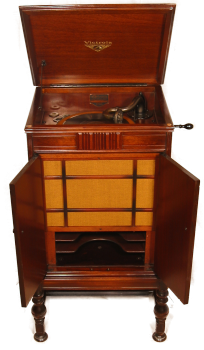 ORTHOPHONIC
VICTROLA or ELECTROLA.
By the mid-1920's, Victor updated its
product line, which included advanced horn and soundbox designs
(designated as Orthophonic Victrolas)
or with electronic amplification, radios and automatic record
changers (designated as Electrolas).
Some of these phonographs were installed in very large decorative cabinets, and
were quite expensive at the time. They came in all shapes and sizes from
1925-1929.
ORTHOPHONIC
VICTROLA or ELECTROLA.
By the mid-1920's, Victor updated its
product line, which included advanced horn and soundbox designs
(designated as Orthophonic Victrolas)
or with electronic amplification, radios and automatic record
changers (designated as Electrolas).
Some of these phonographs were installed in very large decorative cabinets, and
were quite expensive at the time. They came in all shapes and sizes from
1925-1929.
DEALER TAGS
Various emblems/decals/tags may also appear at various locations on your Victor product (examples below). These were usually placed on the phonograph by the selling dealer, and were simply added for advertising purposes. Even other music machine companies like Wurlitzer sold Victor machines, so these logos may also appear. They do not add value to your machine, however they do identify where it was originally sold. A listing of some of the historical Victor Retail Dealers can be found here. Machines sold in Canada may have a "Berliner" tag present under the serial number plate.
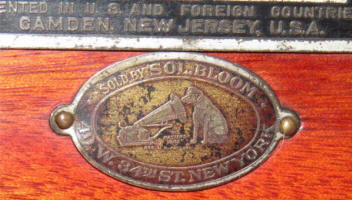
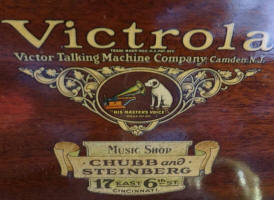
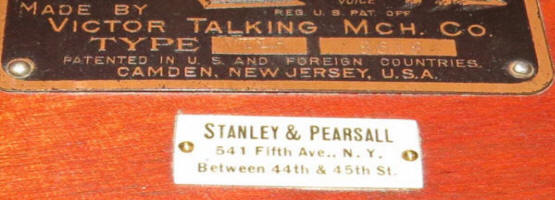
A few of the dealer decals/plates typically installed on Victor products. Some are located near the metal dataplate, and some are under the lid.
FAKE VICTOR PRODUCTS:
This is an important topic, which unfortunately must be addressed. We get hundreds of emails every month from folks who have found or purchased a "Victor" phonograph which is not legitimate. There are dishonest sellers all over the world who misrepresent phonographs in numerous ways; since the demand for external horn Victor phonographs is quite high, there is often a financial incentive to create a "fake". Some are marketed simply as decorations or for movie props, but many are sold as legitimate antiques, and end-up in the hands of an unsuspecting buyer. One common fraud is to make a "Frankenphone" by piecing-together bits and pieces from all kinds of phonographs, both new and old. Reproduction phonograph cabinets, horns and components are still being made in China and India, and are frequently seen on EBay and elsewhere. Some are "artificially aged" to appear old. Another dishonest scheme is to put a legitimate "VICTOR" identification plate on a cheap off-brand or reproduction machine They are frequently passed-off as valuable and legitimate antiques. Be aware that Victor produced machines and cabinets of the highest quality. The typical cheesy quality which is found in the metal parts or an overly-glassy smooth pine cabinet is a dead giveaway of a fake Victor. These replicas have no collector value whatsoever. A few of the signs of a "phony-phonograph" are seen in the images below.
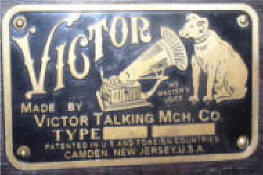
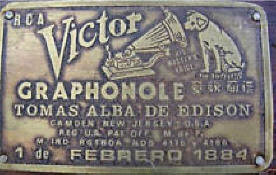
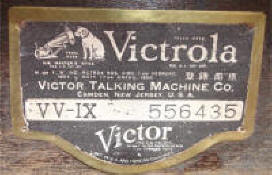
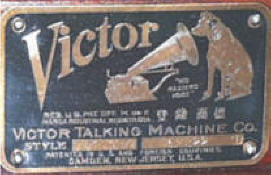
Nipper on Steroids: There are many different styles of reproduction dataplates, which are often placed on fake machines. None of them have high-quality graphics. From left to right: 1) the dog on this Chinese-made reproduction plate has apparently been undergoing illegal steroid treatments causing his muscles to bulge and his head to shrink. 2) A reproduction plate from Mexico made by someone who has been sampling too much tequila. Both Victor and Edison brands are represented on this plate, along with the meaningless term "Graphonole" and a random 1884 date. RCA is also mentioned just to make it more confusing. Makes absolutely no sense. 3) a "cut-out" plate from a legitimate 1920's Victrola model that was mounted on a fake external horn machine to make it appear authentic. 4) The real thing. Victor had very high quality control when these plates were made, and never produced poorly designed or cheaply struck examples. While there are several different versions of authentic plates, the quality of the trademark's logo and "Victor" wording were always excellent; however, the stamped model number and serial number information on original machines could get a bit sloppy at times. Unfortunately, correct original plates are often removed from junked Victrolas and placed on cheap reproduction machines. There are a lot of clever crooks out there!
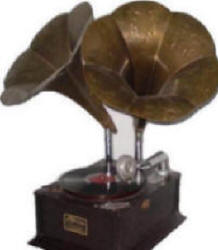
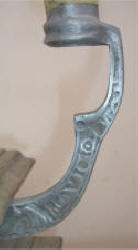
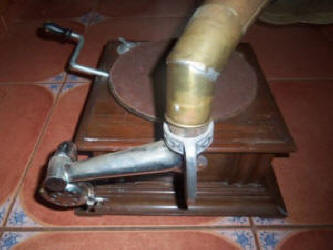
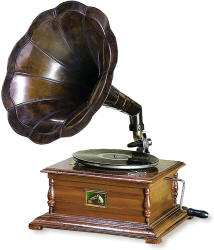
Low Quality and Goofy-Looking Designs are a Sure Indication of a Fake: From left to right: 1) Victor never made "dual" horn models, and a correct Victor metal horn was never embossed with designs. Legitimate horns never point this sharply upward. 2) The crude and uneven quality of this cast backbracket holding the horn is a dead giveaway of a cheap reproduction machine (never mind that "RCA Victor" appears in weak lettering on a phonograph supposedly made years before the RCA Corporation even existed). 3) This monstrosity is a poster-child for cheap reproductions. Poorly soldered joints, a soundbox "dangling" from the tonearm without a support, the crank in the wrong location sticking out awkwardly at an angle from under the turntable, and a cheap pine case. Note that the angle of the horn elbows on these fakes are very sharp and abrupt. Victor always produced elbows with smoothly rounded corners. 4) It might look nice, but it is a reproduction. A dark-stained pine cabinet, crooked-sitting soundbox, and crude details point to a modern reproduction. Again, the angle of the horn elbow is very sharp. Buyer beware!
So, just as a reminder, before we go forward....

